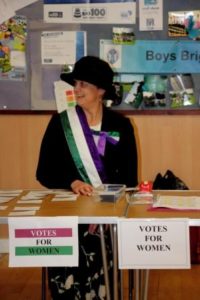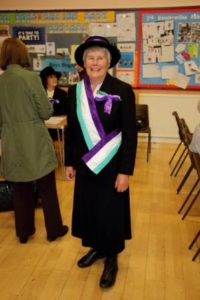Talks
January 2018 Meeting
Thursday 18th January
“Pictish Settlement, East Lomond Hill” Oliver O’Grady and Joe Fitzpatrick
Anyone who watched “Digging for Britain” will have seen a little of this archaeological dig in the 6th December episode. We are delighted to have the leaders of the project visit us for our first meeting of 2018, where we will see and hear much more detail about this little understood period, and at a very nearby location. If you missed the programme, it is worth trying to catch it on the BBC iplayer.
Oliver is an archaeologist who specialises in landscape research and community heritage projects. He is a Fellow of the Society of Antiquaries of Scotland, holds a PhD in Archaeology from the University of Glasgow. He has worked for the Royal Commission on Ancient and Historical Monuments of Scotland and Perth and Kinross Heritage Trust, and has directed archaeological excavations at Iron Age and medieval sites throughout Scotland, most notably in 2008-09 at Scone Palace, the Scottish royal coronation site.
Joe is a Director and Trustee of the Falkland Stewardship Trust which is responsible for many aspects of the Falkland Estate. Since his retirement as a Head of Service in Education and then Communities Services with Fife Council, he devotes much of his time to history, archaeology and community involvement. He is the Project Director for the Trust’s ‘Connecting Communities to their Ancient Landscape’ project, which commissioned the 2017 excavations on East Lomond. Joe lives in Fife and is married with two grown up sons.
November 2017 Meeting
16th November 2017
“Dunfermline/Trondheim Connection” by Gifford Lind
Gifford Lind is the Honorary Convenor of the Dunfermline-Trondheim Twinning Association. Originally from Greenock, Gifford has lived in Dunfermline since 1974. In his professional life he was employed in the Tavistock Institute of Human Relations, working on projects for central and local government, and the EU. He also spent time working as a lecturer in Corporate Planning at Napier College/Polytechnic, before becoming self employed and pursuing his interests in folk music and community song.
The Twinning Association was established in 1997 with the aim of promoting and fostering friendship and understanding between the people of Dunfermline and Trondheim. We are looking forward to learning more about the historic connections between our cities.
As usual, we meet at The Abbey Church Halls, Abbey Park Place, Dunfermline, at 7:30 pm on the third Thursday of the month. We look forward to welcoming visitors and members to the third meeting of the session.
October 2017 Meeting
19 October 2017
At this meeting George Robertson presented “The Lost Village of Lassodie”, the talk originally scheduled for next April, due to the unexpected unavailablity of our advertised speaker.
We were delighted that George was able to present his excellent and informative talk at such short notice. More information about Lassodie is available in Georges articles “The Lost Village of Lassodie” and “A Childhood in Lassodie“.
As usual, we meet at The Abbey Church Halls, Abbey Park Place, Dunfermline, at 7:30 pm on the third Thursday of the month. We look forward to welcoming visitors and members to the second meeting of the session.
September 2017 Meeting
Prof. Sarah Pedersen of Robert Gordon’s University, Aberdeen, gave a fascinating talk on the history of the Suffragette movement in Scotland. She covered the development of the movement from the constitutional Suffragist organisation of Millicent Fawcett through the more militant Women’s Social and Political Union (WSPU), otherwise known as the Suffragettes, lead by Emmeline Pankhurst and, in Scotland, Teresa Billington-Grieg and Helen Fraser. Prof. Pedersen presented a very lively coverage of Suffragette activities in Dunfermline and across Scotland including the demonstrations, interventions in elections and the incidents of violence against property. She covered the whole period until the suspension of the campaign on the outbreak of the First World War and the partial success after the war, when voting rights were granted to some women over 30. Full emancipation was not achieved until 1928.
The topic inspired some of our members to turn out in appropriate dress, featuring the Suffragette colours of Green, White and Violet, or Give Women the Vote.
Sarah is Professor of Communication and Media at Robert Gordon’s University, Aberdeen. Her research interests are focused on women’s engagement with media, whether that is contemporary digital media, or historical newspaper archives. Her research on the suffragettes in Scotland is based around analysis of local newspaper archives and this summer Palgrave Macmillan published her book ‘The Scottish Suffragettes and the Press.
Robert Henryson
At our April 2017 meeting, Dr. Morna Fleming presented a fascinating talk on “Robert Henryson’s Morall Fabillis”. She gave us an excellent introduction to this major work by the 15th Century Dunfermline poet, which stimulated many questions from the audience. She finished by giving us a couple of book recommendations and some website links “for further exploration”, which I’ve listed here.
- The Testament of Cresseid & Seven Fables, translated by Seamus Heaney (Faber, 2008)
- Among His Personal Effects, by Craig McDonald
- The Robert Henryson Society website at
- The original Glasgow University Robert Henryson site at
- http://www.arts.gla.ac.uk/STELLA/STARN/poetry/HENRYSON/homepage.htm
- this site includes a modernised edition of the Thirteen Moral Fables by R.W. Smith.
- A dramatised reading of the Testament of Cresseid by Colin Donalti and Morna Fleming at


